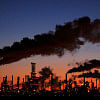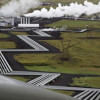QUIRKY SCIENCE

Global fossil-fuel emissions
Annual global carbon dioxide emissions from fossil fuels could drop slightly in 2015, according to a report from the Global Carbon Project led by a Stanford University researcher. This surprising result contrasts with the rapid growth in emissions before 2014, underlining the need for action to stabilize and permanently lower global CO2 emissions, the researchers conclude.
"In 2014, global CO2 emissions from burning fossil fuels grew by just 0.6 percent," said lead author Rob Jackson, a professor of Earth system science at Stanford. "This year we expect total emissions to flatten or drop slightly, despite strong growth in gross domestic product worldwide."
While CO2 emissions have slowed during times of economic recession, this would be the first decline during a period of strong global economic growth, Jackson said.
The new report, titled "Reaching Peak Emissions," was published on Dec. 7 in the journal Nature Climate Change, with detailed data published simultaneously in Earth System Science Data.
"Decreased coal use in China was largely responsible for the decline in global CO2 emissions," said report co-author Corinne Le Quéré of the University of East Anglia in the United Kingdom. "After a decade of rapid growth, China's emissions rate slowed to 1.2 percent in 2014 and is expected to drop by 3.9 percent in 2015."
The researchers identified China as the world's top CO2 emitter in 2014, responsible for 27 percent of global emissions, followed by the United States (15.5 percent), the European Union (9.5 percent) and India (7.2 percent).

Hubble Sees the Force Awakening
Just in time for the release of the movie "Star Wars Episode VII: The Force Awakens," NASA's Hubble Space Telescope has photographed what looks like a cosmic, double-bladed lightsaber.
In the center of the image, partially obscured by a dark, Jedi-like cloak of dust, a newborn star shoots twin jets out into space as a sort of birth announcement to the universe.
"Science fiction has been an inspiration to generations of scientists and engineers, and the film series Star Wars is no exception," said John Grunsfeld, astronaut and associate administrator for NASA's Science Mission Directorate. "There is no stronger case for the motivational power of real science than the discoveries that come from the Hubble Space Telescope as it unravels the mysteries of the universe."
This celestial lightsaber does not lie in a galaxy far, far away, but rather inside our home galaxy, the Milky Way. It's inside a turbulent birthing ground for new stars known as the Orion B molecular cloud complex, located 1,350 light-years away.
When stars form within giant clouds of cool molecular hydrogen, some of the surrounding material collapses under gravity to form a rotating, flattened disk encircling the newborn star. Though planets will later congeal in the disk, at this early stage the protostar is feeding on the disk with a Jabba-like appetite. Gas from the disk rains down onto the protostar and engorges it. Superheated material spills away and is shot outward from the star in opposite directions along an uncluttered escape route -- the star's rotation axis.
Source: Sciencedaily.com

 For all latest news, follow The Daily Star's Google News channel.
For all latest news, follow The Daily Star's Google News channel. 








Comments